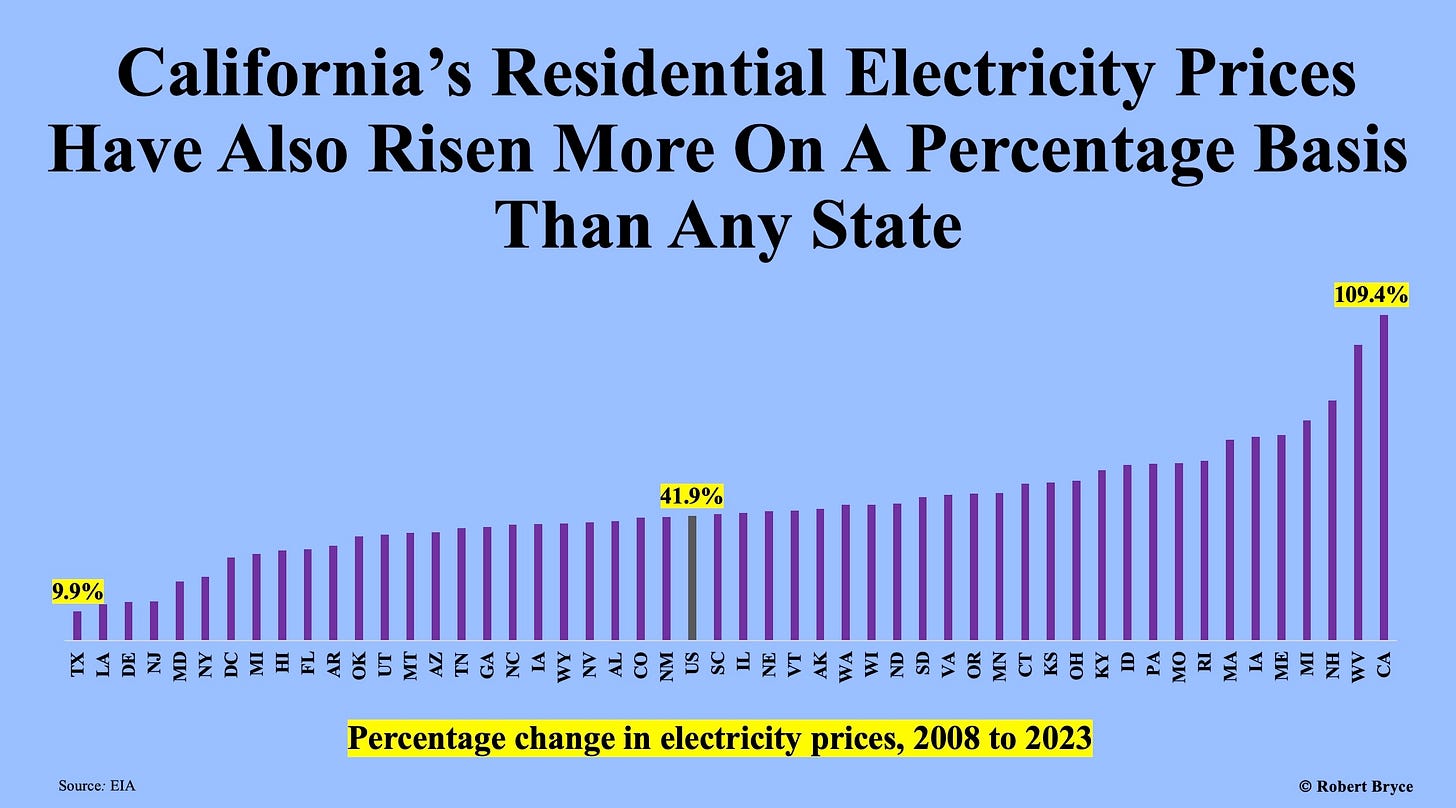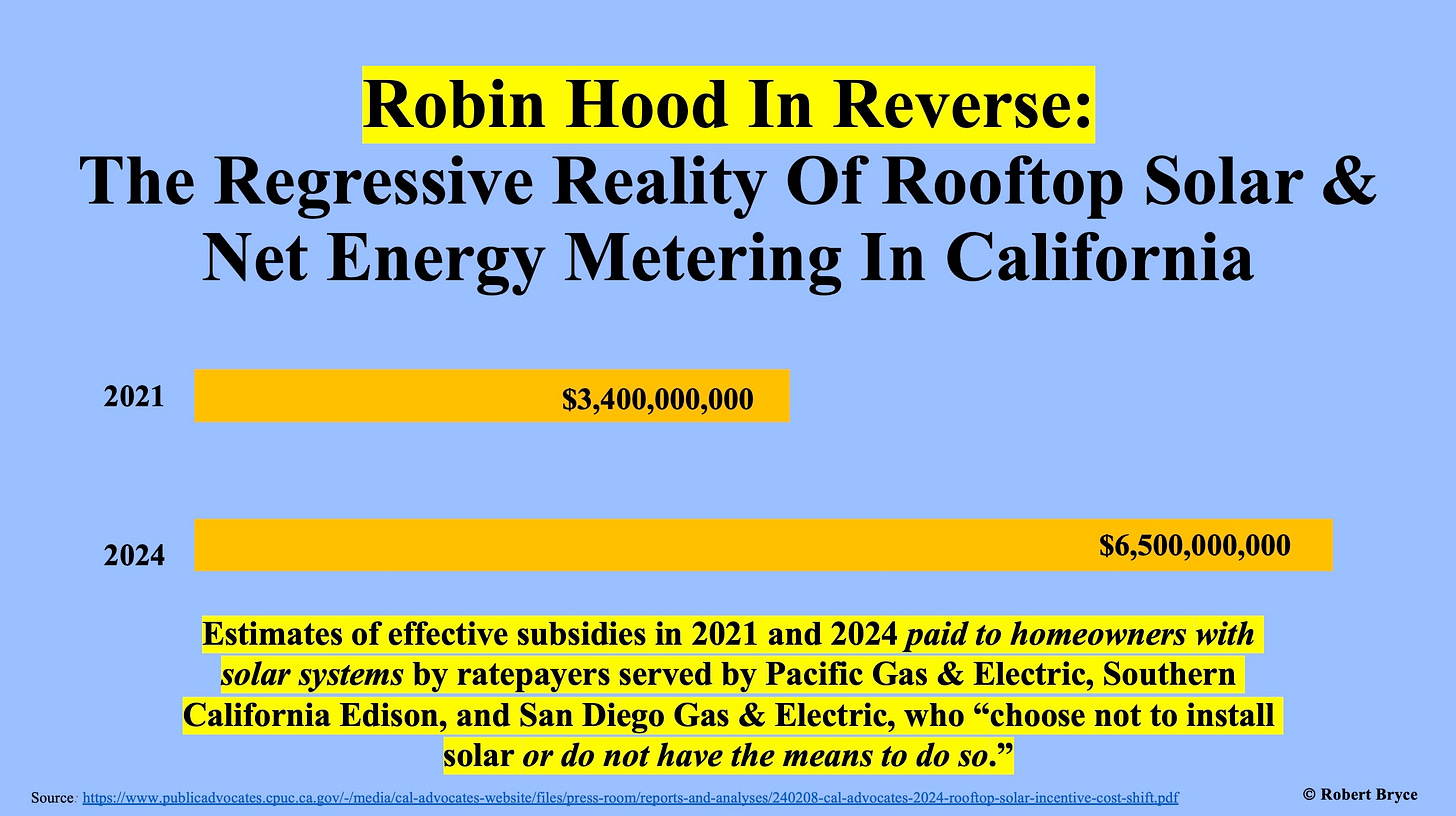California’s Electricity Disaster In Seven Charts
Residential electricity prices jumped nearly 12% in 2023 and they are going higher. But the carbon intensity of power generation isn’t falling and low-income ratepayers are subsidizing the rich.
California’s energy woes are getting worse. According to the latest numbers from the Energy Information Administration, the state’s residential electricity prices, already among the highest in America, jumped by 3 cents per kilowatt-hour last year, an increase of 11.9%. The average California homeowner now pays 28.9 cents per kilowatt-hour for electricity, which is the third-highest price in the U.S., behind only Connecticut and Hawaii.
Unfortunately, the 2023 price increases are only a hors d’oeuvre. California’s electric rates are headed for the exosphere. As I explained last March in “California Screamin,” in 2022:
The California Public Utilities Commission unanimously approved a scheme that aims to add more than 25 gigawatts of renewables and 15 gigawatts of batteries to the state’s electric grid by 2032 at an estimated cost of $49.3 billion. In addition, the California Independent System Operator released a draft plan to upgrade the state’s transmission grid at a cost of some $30.5 billion. The combined cost of those two schemes is about $80 billion.
Given the raging inflation in utility products, that $80 billion estimate is undoubtedly too low. Whatever the ultimate price tag, the state’s aggressive alt-energy plans will inflict more economic pain on the low-income residents of a state with the dubious distinction of having the highest poverty rate in the United States.
From natural gas bans to aggressive alt-energy mandates and bans on vehicles with internal combustion engines, the Golden State provides a clear example of what not to do. While California’s lunatic energy policy decisions go back decades, the most relevant regulations began in 2008. That’s when, as McClatchy newspapers explained:
Governor Arnold Schwarzenegger signed an executive order calling on utilities to provide one-third of their power from renewable resources by 2020. “This will be the most aggressive target in the nation,” he said. Increased reliance on renewable energy conceivably could hike future rates, however, because of higher production costs and the need to upgrade transmission facilities. Schwarzenegger’s order came on the eve of today’s international summit on global climate change in Los Angeles. (Emphasis added.)
These seven charts show how California’s electricity policies have unfolded since 2008.
Chart 1
The following chart uses a graphic created by Grant Chalmers, who works in information technology at the University of Brisbane. It shows that despite the massive increases in wind and solar production, the carbon intensity of California’s electric generation isn’t falling. To be clear, total electricity use in California is falling. All-sector electricity use in the state fell 11.2% between 2008 and 2023. (Hat tip to Joe Toomey.) That reduction in power use has likely helped reduce the state’s overall CO2 emissions, which, as seen in this December 14, 2023, California Air Resources Board report, have declined since 2008. But California is nowhere near net zero, and the carbon intensity of electricity production hasn’t budged in more than a decade.
Chart 2
Meanwhile, the state’s electricity prices are exploding.
Chart 3
Chart 4
The following chart shows the latest figures from the Bureau of Labor Statistics. Although the average price of residential electricity in California is 28.9 cents per kilowatt-hour, it’s even more expensive in the state’s biggest cities.
Chart 5
A devastating February 8 report from The Public Advocates Office, estimated that rooftop solar incentives in California will cost “customers without solar an estimated $6.5 billion in 2024.” The report is astonishing for its brevity and its findings. The office, which is part of the California Public Utility Commission, concluded that the cost of solar subsidies for ratepayers who don’t have solar has nearly doubled since 2021. It explains: “The recent cost increases are driven by two main factors: (1) a surge in customers installing solar prior to the phase out of unsustainably lucrative program compensation terms, and (2) higher compensation to customers with rooftop solar for the excess energy their systems generate.” The report goes on, saying the main incentive for homeowners to install rooftop solar is a program called net energy metering which compensates those homeowners for “the electricity they generate by more than seven times its relative value to the grid.” (Emphasis added.) It continues:
The Public Advocates Office estimates Pacific Gas and Electric, Southern California Edison, and San Diego Gas & Electric customers without solar will pay an additional $6.5 billion in 2024 to support the program. In 2021, the cost was approximately $3.4 billion. Our analysis estimates that in 2024, more than 15% of the average household’s electricity bill will go to subsidizing the program across all utilities if they do not have solar. The amount has trended upward in recent years: the program made up 8 to 17% of the average customer’s bill in 2022, according to a prior CPUC estimate.
On January 10, less than a month before the Public Advocates Office published its report on rooftop solar, the Legislative Analyst’s Office sent a 16-page letter to Senator Maria Elena Durazo, a Democrat from central Los Angeles, that detailed the myriad ways in which California’s climate policies — in the words of The Two Hundred for Homeownership, a non-profit group that advocates for low- and moderate-income communities — “disproportionately burden lower-income people.” The letter found that the state’s net metering policies for rooftop solar:
Have historically subsidized electricity costs for households with rooftop solar while raising them for everyone else and researchers note that NEM is one driver of high increases in residential electricity prices. The average customer without rooftop solar pays 10 percent to 20 percent on their electricity bills to subsidize rooftop solar on the homes of others. (Emphasis added.)
None of this should be surprising. I spotlighted the class divide over solar energy and the transfer of wealth from poor to rich in 2017 in the Wall Street Journal. I wrote:
According to a study done for the California Public Utility Commission, residents who have installed solar systems have household incomes 68% higher than the state average. Ashley Brown, executive director of the Harvard Electricity Policy Group, calls the proliferation of rooftop solar systems and the returns they provide to lucky people like me, “a wealth transfer from less affluent ratepayers to more affluent ones.” It is, Mr. Brown says, “Robin Hood in reverse.”
This graphic shows the change in effective solar subsidies between 2021 and 2024. Rooftop solar and net energy metering would have horrified Robin and other denizens of Sherwood Forest.
Chart 6
There’s plenty of evidence the state’s energy mandates are punishing low-income Californians. On March 10, Rob Nikolewski, a sharp-eyed reporter at the San Diego Union-Tribune, published an article that began, “Roughly one-quarter of San Diego Gas & Electric customers are still behind on their monthly bills.” He continued, saying that about 3.48 million California ratepayers had “fallen behind on their monthly payments, as of January.” He then quoted Mark Wolfe, the executive director at the National Energy Assistance Directors Association, who said the numbers in California are “alarming.” Wolfe added: “The underlying problem is energy is very expensive in California and it’s not surprising to see people owing as much as they do.”
Chart 7
Given California’s soaring energy costs and exorbitant cost of living, it’s unsurprising that people are leaving for less-expensive pastures. In December, the Census Bureau reported that California lost some 75,000 residents in 2023, an exodus surpassed only by New York, which lost about 102,000 people. In January, Fox News reported, “For the fourth year in a row, liberal California topped U-Haul’s Growth Index list for having the largest net outbound movers in 2023.”
https://robertbryce.substack.com/p/californias-electricity-disaster
You can return to the main Market News page, or press the Back button on your browser.








